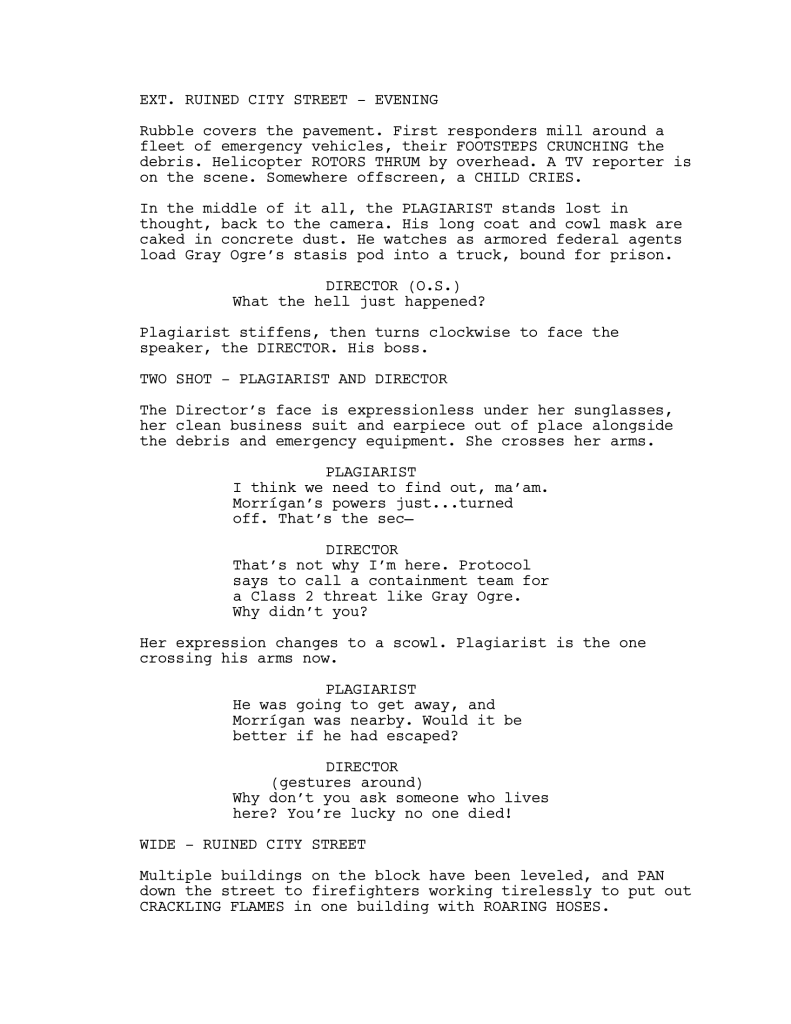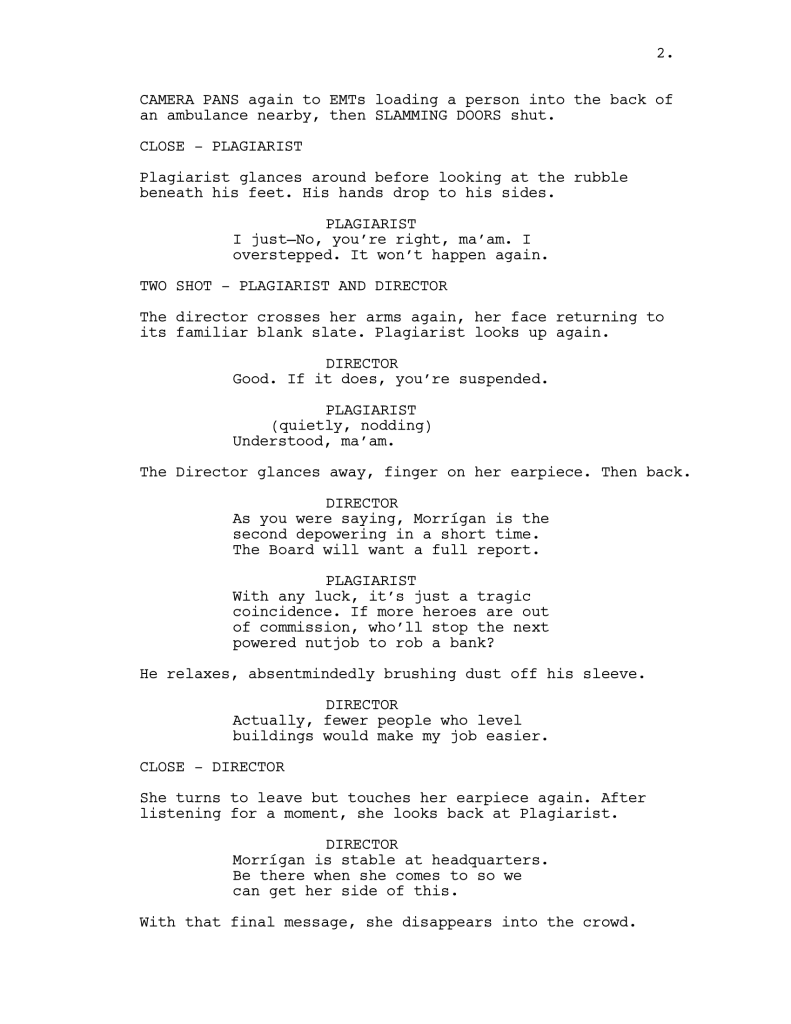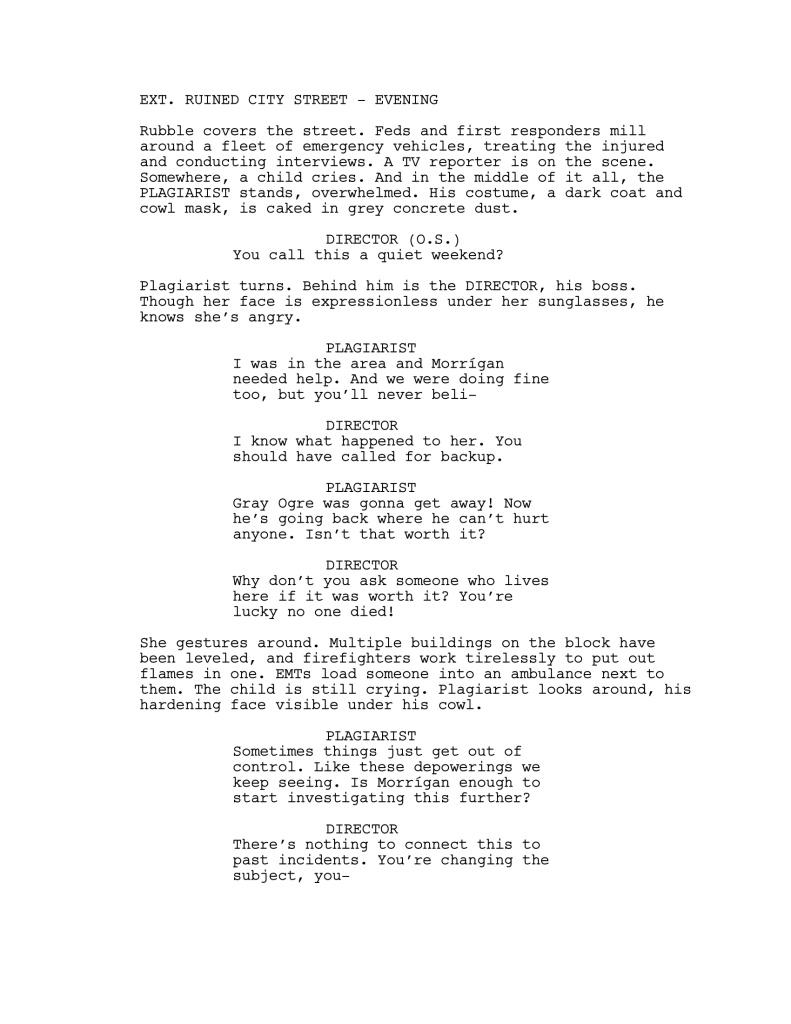

Project Details
- Role: Narrative Designer
- Team: Solo Project
- Project Type: Cutscene Screenplay
- Major Tools: Final Draft
- Time Frame: Jan. – Mar. 2023
A short screenplay depicting a cutscene for a hypothetical superhero action-adventure game, “Powerless”. This scene comes early in the story, and mainly serves to introduce a new supporting character, the Director. However, it also provides an emotional beat for the protagonist, and sets up further gameplay scenes.


Initial Concept
No cutscene exists in a vacuum, so I created a hypothetical game concept to use as a foundation when writing the screenplay. I’m a big fan of superhero comics, so I decided on a concept that would let me try my hand at a game about superheroes. Knowing my end goal was to create only a small part of the game’s larger narrative, I kept the concept to the very basics: a logline, tone, game genre, and a simple brainstorm of what its overall narrative arc might look like. This was all good information that I could draw on when outlining my cutscene, and is attached above as slides. If this were for an existing game project, I’d already have this information, but here I had the luxury of coming up with it on my own!
After that, I needed to decide on what the screenplay would depict. From the start, I knew that I wanted a dialogue-driven scene between two characters that showed the different ways that characters view superheroes in the game world. I could immediately use my protagonist concept, a secret agent who idolizes superheroes and wants to be like them. I decided to use the scene to contrast him against his boss, the director of his agency who views superheroes more as giant toddlers she cleans up after. The setting could even illustrate her point, the aftermath of a massive superhero battle. That provided clear gameplay context: the player just finished a fight scene, and then gets pulled into the cutscene. With that, I had plenty of context to create a cutscene.
| Character Name | Character Summary | Scene Goals |
|---|---|---|
| The Plagiarist | The protagonist, a secret agent with the ability to mimic superpowers. | To convince his boss of the need to investigate the depowering of superheroes. |
| The Director | The Plagiarist’s boss, the head of a defense agency against superhumans. | To get Plagiarist to admit he was reckless for the destructive, mid-city fight he was just in. |
Outlining
With the initial concept in place, I began to block out the structure of my script. I made sure to establish both characters involved in the scene, giving them short profiles and goals to work toward in the scene. These are summarized in the table above. I also laid out my own goals for the scene, things that I wanted to communicate to the player:
- The Plagiarist and his boss have rapport, but clashing personalities. The Director is driven by following the rules, whereas the Plagiarist has an often misguided desire to chase ideals.
- Not everyone idolizes superheroes like the Plagiarist. The Director views them as something that needs to be controlled and cleaned up after.
- Establish that the next gameplay scene will be more social and investigative in nature.
With these in mind to light the way, I laid out the rough pacing of the scene. I figured that I needed to spend the first beats simply establishing the setting, and then move into dialogue. The Director and the Plagiarist would then present their cases to each other, essentially talking past each other as they have different goals in mind. However, at the midpoint, the Plagiarist would realize his recklessness in a more emotional beat. With her goal accomplished, she lets him advocate for a new investigation. With that rough outline, I was able to block out my first draft.


Revisions
I made this for a project in a narrative design course, so I was fortunate to have a group of people to workshop my screenplay with once I had a first draft written. It went through several rounds of feedback in a writer’s circle, where I was also able to give feedback on other screenplays. This was the first time I participated in that kind of collaborative writing process, and it was a humbling experience. However, it also showed me how powerful it is to get a large amount of feedback over time. I could drill down on the issues in my screenplay and experiment with multiple solutions.
By the time I was finished with the project, I had gone through four total drafts, with the final being a retrospective one after the class assignment was finished. Major points of criticism during the initial workshop centered around the dialogue being too wordy and character voices being too indistinct. Some readers also thought that the dialogue required too much context to understand. These were the major focuses of my attention when I revised my drafts. As you can see from my first take on the screenplay above, I cut down the length of dialogue significantly to make lines snappier. I was also a beginner at writing screenplay format, so I avoided references to key concepts like camera movement. I made sure to read a lot of professional screenplays to see examples of this and my use of the format improved significantly over the course of the project.